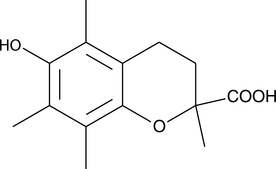Chemicals
Showing 38851–39000 of 41137 results
-
Tris(4,7-diphenyl-1,10-phenanthroline)ruthenium II dichloride complex is a luminescent probe (absorption λmax: 455 nm, luminescence λmax: 613 nm) widely used for detection and quantitation of oxygen.{26592} The dye is strongly reduced by molecular oxygen as a result of dynamic quenching; thus oxygen detection can be based on either measurement of intensity or decay time.{26591} This oxygen probe has been used to optimize optical oxygen sensors, to measure oxygen flux through tissues and in skin tumors, and for oxygen imaging.{26592,26594,26604,26590,26593}
Brand:CaymanSKU:-Triticonazole is a triazole fungicide used for the control of common soil and seed-borne diseases on cereals and other crops.{30331} The antifungal effects of triticonazole are due to its ability to inhibit ergosterol biosynthesis.{30331}
Brand:CaymanSKU:-Available on backorder
TRO 19622 is an orally bioavailable mitochondrial-targeted neuroprotective agent that binds to and inhibits opening of the mitochondrial permeability transition pore (mPTP).{39891,39892} It prevents mPTP opening induced by arachidonic acid (Item No. 90010) in HeLa cells when used at a concentration of 10 µM.{39891} TRO 19622 promotes survival of motor neurons in vitro in a concentration-dependent manner in the absence of neurotrophic factors (EC50 = 3.2 µM) and in vivo in a neonatal rat model of facial nerve axotomy when administered at a dose of 100 mg/kg per day.{39892} It delays onset of motor deficits and extends survival in the SOD1G93A transgenic model of amyotrophic lateral sclerosis (ALS). TRO 19622 (30 and 100 mg/kg) also increases the latency to paw withdrawal in a mechanical hyperalgesia test in rat models of streptozotocin-induced diabetic and vincristine-induced neuropathic pain but not in models of acute, inflammatory, or injury-induced pain.{39893}
Brand:CaymanSKU:21264 -Out of stock
TRO 19622 is an orally bioavailable mitochondrial-targeted neuroprotective agent that binds to and inhibits opening of the mitochondrial permeability transition pore (mPTP).{39891,39892} It prevents mPTP opening induced by arachidonic acid (Item No. 90010) in HeLa cells when used at a concentration of 10 µM.{39891} TRO 19622 promotes survival of motor neurons in vitro in a concentration-dependent manner in the absence of neurotrophic factors (EC50 = 3.2 µM) and in vivo in a neonatal rat model of facial nerve axotomy when administered at a dose of 100 mg/kg per day.{39892} It delays onset of motor deficits and extends survival in the SOD1G93A transgenic model of amyotrophic lateral sclerosis (ALS). TRO 19622 (30 and 100 mg/kg) also increases the latency to paw withdrawal in a mechanical hyperalgesia test in rat models of streptozotocin-induced diabetic and vincristine-induced neuropathic pain but not in models of acute, inflammatory, or injury-induced pain.{39893}
Brand:CaymanSKU:21264 -Out of stock
TRO 19622 is an orally bioavailable mitochondrial-targeted neuroprotective agent that binds to and inhibits opening of the mitochondrial permeability transition pore (mPTP).{39891,39892} It prevents mPTP opening induced by arachidonic acid (Item No. 90010) in HeLa cells when used at a concentration of 10 µM.{39891} TRO 19622 promotes survival of motor neurons in vitro in a concentration-dependent manner in the absence of neurotrophic factors (EC50 = 3.2 µM) and in vivo in a neonatal rat model of facial nerve axotomy when administered at a dose of 100 mg/kg per day.{39892} It delays onset of motor deficits and extends survival in the SOD1G93A transgenic model of amyotrophic lateral sclerosis (ALS). TRO 19622 (30 and 100 mg/kg) also increases the latency to paw withdrawal in a mechanical hyperalgesia test in rat models of streptozotocin-induced diabetic and vincristine-induced neuropathic pain but not in models of acute, inflammatory, or injury-induced pain.{39893}
Brand:CaymanSKU:21264 -Out of stock
Trofosfamide is a nitrogen mustard alkylating agent and a derivative of cyclophosphamide (Item No. 13849) that has antiproliferative activities.{52010,52011} It increases the number of micronucleated polychromatic red blood cells isolated from mouse bone marrow, indicating cytogenetic activity, when administered at doses of 40, 80, and 160 mg/kg.{52009} Trofosfamide (100 mg/kg) inhibits proliferation of isolated splenocytes in the allogenic mixed lymphocyte reaction.{52010} It reduces sheep red blood cell-induced increases in the number of antibody-producing spleen cells isolated from rats when administered at a dose of 40 mg/kg.{52011}
Brand:CaymanSKU:21874 -Out of stock
Trofosfamide is a nitrogen mustard alkylating agent and a derivative of cyclophosphamide (Item No. 13849) that has antiproliferative activities.{52010,52011} It increases the number of micronucleated polychromatic red blood cells isolated from mouse bone marrow, indicating cytogenetic activity, when administered at doses of 40, 80, and 160 mg/kg.{52009} Trofosfamide (100 mg/kg) inhibits proliferation of isolated splenocytes in the allogenic mixed lymphocyte reaction.{52010} It reduces sheep red blood cell-induced increases in the number of antibody-producing spleen cells isolated from rats when administered at a dose of 40 mg/kg.{52011}
Brand:CaymanSKU:21874 -Out of stock
Trofosfamide is a nitrogen mustard alkylating agent and a derivative of cyclophosphamide (Item No. 13849) that has antiproliferative activities.{52010,52011} It increases the number of micronucleated polychromatic red blood cells isolated from mouse bone marrow, indicating cytogenetic activity, when administered at doses of 40, 80, and 160 mg/kg.{52009} Trofosfamide (100 mg/kg) inhibits proliferation of isolated splenocytes in the allogenic mixed lymphocyte reaction.{52010} It reduces sheep red blood cell-induced increases in the number of antibody-producing spleen cells isolated from rats when administered at a dose of 40 mg/kg.{52011}
Brand:CaymanSKU:21874 -Out of stock
Trofosfamide is a nitrogen mustard alkylating agent and a derivative of cyclophosphamide (Item No. 13849) that has antiproliferative activities.{52010,52011} It increases the number of micronucleated polychromatic red blood cells isolated from mouse bone marrow, indicating cytogenetic activity, when administered at doses of 40, 80, and 160 mg/kg.{52009} Trofosfamide (100 mg/kg) inhibits proliferation of isolated splenocytes in the allogenic mixed lymphocyte reaction.{52010} It reduces sheep red blood cell-induced increases in the number of antibody-producing spleen cells isolated from rats when administered at a dose of 40 mg/kg.{52011}
Brand:CaymanSKU:21874 -Out of stock
Troglitazone is a selective agonist of peroxisome proliferator-activated receptor γ (PPARγ; EC50s = 0.78 and 0.55 μM for the mouse and human receptors, respectively, in a transactivation assay).{10670} It is selective for PPARγ over PPARα and PPARδ, at which it is inactive at concentrations up to 10 μM. Troglitazone (500 mg/kg twice per day) exhibits antihyperglycemic and antihyperlipidemic properties in Zucker diabetic fatty rats, reducing plasma glucose and triglyceride levels by 61 and 87% respectively.{25251} It also induces cell cycle arrest at the G1 phase in SK-HEP-1 and Hep3B hepatocellular carcinoma cells when used at a concentration of 10 μM and increases apoptosis in these cells at concentrations of 30 μM and higher.{10669}
Brand:CaymanSKU:71750 - 10 mgAvailable on backorder
Troglitazone is a selective agonist of peroxisome proliferator-activated receptor γ (PPARγ; EC50s = 0.78 and 0.55 μM for the mouse and human receptors, respectively, in a transactivation assay).{10670} It is selective for PPARγ over PPARα and PPARδ, at which it is inactive at concentrations up to 10 μM. Troglitazone (500 mg/kg twice per day) exhibits antihyperglycemic and antihyperlipidemic properties in Zucker diabetic fatty rats, reducing plasma glucose and triglyceride levels by 61 and 87% respectively.{25251} It also induces cell cycle arrest at the G1 phase in SK-HEP-1 and Hep3B hepatocellular carcinoma cells when used at a concentration of 10 μM and increases apoptosis in these cells at concentrations of 30 μM and higher.{10669}
Brand:CaymanSKU:71750 - 100 mgAvailable on backorder
Troglitazone is a selective agonist of peroxisome proliferator-activated receptor γ (PPARγ; EC50s = 0.78 and 0.55 μM for the mouse and human receptors, respectively, in a transactivation assay).{10670} It is selective for PPARγ over PPARα and PPARδ, at which it is inactive at concentrations up to 10 μM. Troglitazone (500 mg/kg twice per day) exhibits antihyperglycemic and antihyperlipidemic properties in Zucker diabetic fatty rats, reducing plasma glucose and triglyceride levels by 61 and 87% respectively.{25251} It also induces cell cycle arrest at the G1 phase in SK-HEP-1 and Hep3B hepatocellular carcinoma cells when used at a concentration of 10 μM and increases apoptosis in these cells at concentrations of 30 μM and higher.{10669}
Brand:CaymanSKU:71750 - 5 mgAvailable on backorder
Troglitazone is a selective agonist of peroxisome proliferator-activated receptor γ (PPARγ; EC50s = 0.78 and 0.55 μM for the mouse and human receptors, respectively, in a transactivation assay).{10670} It is selective for PPARγ over PPARα and PPARδ, at which it is inactive at concentrations up to 10 μM. Troglitazone (500 mg/kg twice per day) exhibits antihyperglycemic and antihyperlipidemic properties in Zucker diabetic fatty rats, reducing plasma glucose and triglyceride levels by 61 and 87% respectively.{25251} It also induces cell cycle arrest at the G1 phase in SK-HEP-1 and Hep3B hepatocellular carcinoma cells when used at a concentration of 10 μM and increases apoptosis in these cells at concentrations of 30 μM and higher.{10669}
Brand:CaymanSKU:71750 - 50 mgAvailable on backorder
Trolox is a cell-permeable, water-soluble derivative of vitamin E with potent antioxidant properties. It is commonly used as a standard or positive control in antioxidant assays.{12069,13782} In addition, trolox is used to assess the role of oxidative injury in processes like neuronal cell death and aging.{16492,16490} Trolox is effective as adjunctive therapy in the treatment of certain cancers.{16491}
Brand:CaymanSKU:10011659 - 1 gAvailable on backorder
Trolox is a cell-permeable, water-soluble derivative of vitamin E with potent antioxidant properties. It is commonly used as a standard or positive control in antioxidant assays.{12069,13782} In addition, trolox is used to assess the role of oxidative injury in processes like neuronal cell death and aging.{16492,16490} Trolox is effective as adjunctive therapy in the treatment of certain cancers.{16491}
Brand:CaymanSKU:10011659 - 250 mgAvailable on backorder
Trolox is a cell-permeable, water-soluble derivative of vitamin E with potent antioxidant properties. It is commonly used as a standard or positive control in antioxidant assays.{12069,13782} In addition, trolox is used to assess the role of oxidative injury in processes like neuronal cell death and aging.{16492,16490} Trolox is effective as adjunctive therapy in the treatment of certain cancers.{16491}
Brand:CaymanSKU:10011659 - 500 mgAvailable on backorder
Muscarinic receptors are G protein-coupled acetylcholine receptors that play diverse roles. Five subtypes (M1-5) have been identified, which preferentially couple to various effector systems based on their G protein interaction.{27107,27108}Tropicamide is a muscarinic acetylcholine receptor (mAChR) antagonist (pKi = 7.2 in chicken heart) that displays 3-fold selectivity for M4.{27107,27106,27105} When applied as eye drops, it produces temporary mydriasis (pupil dilation; EC50 = 6 µg/ml) and cycloplegia (ciliary muscle paralysis; EC50 = 25 µg/ml).{27109} Tropicamide has been used to probe mAChR activity in a mouse model of fragile X syndrome.{27110}
Brand:CaymanSKU:-Out of stock
Muscarinic receptors are G protein-coupled acetylcholine receptors that play diverse roles. Five subtypes (M1-5) have been identified, which preferentially couple to various effector systems based on their G protein interaction.{27107,27108}Tropicamide is a muscarinic acetylcholine receptor (mAChR) antagonist (pKi = 7.2 in chicken heart) that displays 3-fold selectivity for M4.{27107,27106,27105} When applied as eye drops, it produces temporary mydriasis (pupil dilation; EC50 = 6 µg/ml) and cycloplegia (ciliary muscle paralysis; EC50 = 25 µg/ml).{27109} Tropicamide has been used to probe mAChR activity in a mouse model of fragile X syndrome.{27110}
Brand:CaymanSKU:-Out of stock
Tropifexor is an agonist of farnesoid X receptors (FXR).{48126} It enhances the interaction between the human FXR ligand binding domain and the steroid receptor coactivator 1 (SRC-1) peptide in a homogeneous time-resolved fluorescence (HTRF) coactivator interaction assay (EC50 = 0.2 nM). It increases expression of the FXR target genes BSEP and SHP and decreases expression of CPY8B1 in rat liver in a dose-dependent manner, as well as increases expression of SHP and FGF15 in rat ileum. Tropifexor (0.3 mg/kg) reduces triglyceride levels by 79% in rat serum. It reduces fibrosis, inflammation, and steatosis in a mouse model of nonalcoholic steatohepatitis (NASH).{48127}
Brand:CaymanSKU:25748 - 1 mgAvailable on backorder
Tropifexor is an agonist of farnesoid X receptors (FXR).{48126} It enhances the interaction between the human FXR ligand binding domain and the steroid receptor coactivator 1 (SRC-1) peptide in a homogeneous time-resolved fluorescence (HTRF) coactivator interaction assay (EC50 = 0.2 nM). It increases expression of the FXR target genes BSEP and SHP and decreases expression of CPY8B1 in rat liver in a dose-dependent manner, as well as increases expression of SHP and FGF15 in rat ileum. Tropifexor (0.3 mg/kg) reduces triglyceride levels by 79% in rat serum. It reduces fibrosis, inflammation, and steatosis in a mouse model of nonalcoholic steatohepatitis (NASH).{48127}
Brand:CaymanSKU:25748 - 10 mgAvailable on backorder
Tropifexor is an agonist of farnesoid X receptors (FXR).{48126} It enhances the interaction between the human FXR ligand binding domain and the steroid receptor coactivator 1 (SRC-1) peptide in a homogeneous time-resolved fluorescence (HTRF) coactivator interaction assay (EC50 = 0.2 nM). It increases expression of the FXR target genes BSEP and SHP and decreases expression of CPY8B1 in rat liver in a dose-dependent manner, as well as increases expression of SHP and FGF15 in rat ileum. Tropifexor (0.3 mg/kg) reduces triglyceride levels by 79% in rat serum. It reduces fibrosis, inflammation, and steatosis in a mouse model of nonalcoholic steatohepatitis (NASH).{48127}
Brand:CaymanSKU:25748 - 5 mgAvailable on backorder
Tropifexor is an agonist of farnesoid X receptors (FXR).{48126} It enhances the interaction between the human FXR ligand binding domain and the steroid receptor coactivator 1 (SRC-1) peptide in a homogeneous time-resolved fluorescence (HTRF) coactivator interaction assay (EC50 = 0.2 nM). It increases expression of the FXR target genes BSEP and SHP and decreases expression of CPY8B1 in rat liver in a dose-dependent manner, as well as increases expression of SHP and FGF15 in rat ileum. Tropifexor (0.3 mg/kg) reduces triglyceride levels by 79% in rat serum. It reduces fibrosis, inflammation, and steatosis in a mouse model of nonalcoholic steatohepatitis (NASH).{48127}
Brand:CaymanSKU:25748 - 500 µgAvailable on backorder
Tropine is a naturally-occurring tropane alkaloid extracted primarily from plants of the Solanaceae family.{22119} It serves as an intermediate in the synthesis of a variety of bioactive alkaloids, including atropine (Item No. 12008), benztropine (Item No. 18214), and scopolamine, many of which have potent neurological actions.{22119,30247}
Brand:CaymanSKU:-Available on backorder
Tropine is a naturally-occurring tropane alkaloid extracted primarily from plants of the Solanaceae family.{22119} It serves as an intermediate in the synthesis of a variety of bioactive alkaloids, including atropine (Item No. 12008), benztropine (Item No. 18214), and scopolamine, many of which have potent neurological actions.{22119,30247}
Brand:CaymanSKU:-Available on backorder
Tropine is a naturally-occurring tropane alkaloid extracted primarily from plants of the Solanaceae family.{22119} It serves as an intermediate in the synthesis of a variety of bioactive alkaloids, including atropine (Item No. 12008), benztropine (Item No. 18214), and scopolamine, many of which have potent neurological actions.{22119,30247}
Brand:CaymanSKU:-Available on backorder
Tropine is a naturally-occurring tropane alkaloid extracted primarily from plants of the Solanaceae family.{22119} It serves as an intermediate in the synthesis of a variety of bioactive alkaloids, including atropine (Item No. 12008), benztropine (Item No. 18214), and scopolamine, many of which have potent neurological actions.{22119,30247}
Brand:CaymanSKU:-Available on backorder
Tropisetron is an orally-bioavailable antagonist of the serotonin (5-HT) receptor 5-HT3 (Ki = 5.3 nM).{33369,33371} Antagonists of 5-HT3, including tropisetron, have been shown to prevent nausea and emesis in patients undergoing chemotherapy in clinical trials.{33373,33374} Tropisetron is also an antagonist of the α9 nicotinic acetylcholine receptor (nAChR; IC50 = 166 nM) and a partial agonist of α7 nAChR (Ki = 6.9 nM).{33372,33370}
Brand:CaymanSKU:21240 -Out of stock
Tropisetron is an orally-bioavailable antagonist of the serotonin (5-HT) receptor 5-HT3 (Ki = 5.3 nM).{33369,33371} Antagonists of 5-HT3, including tropisetron, have been shown to prevent nausea and emesis in patients undergoing chemotherapy in clinical trials.{33373,33374} Tropisetron is also an antagonist of the α9 nicotinic acetylcholine receptor (nAChR; IC50 = 166 nM) and a partial agonist of α7 nAChR (Ki = 6.9 nM).{33372,33370}
Brand:CaymanSKU:21240 -Out of stock
Tropisetron is an orally-bioavailable antagonist of the serotonin (5-HT) receptor 5-HT3 (Ki = 5.3 nM).{33369,33371} Antagonists of 5-HT3, including tropisetron, have been shown to prevent nausea and emesis in patients undergoing chemotherapy in clinical trials.{33373,33374} Tropisetron is also an antagonist of the α9 nicotinic acetylcholine receptor (nAChR; IC50 = 166 nM) and a partial agonist of α7 nAChR (Ki = 6.9 nM).{33372,33370}
Brand:CaymanSKU:21240 -Out of stock
Tropisetron is an orally-bioavailable antagonist of the serotonin (5-HT) receptor 5-HT3 (Ki = 5.3 nM).{33369,33371} Antagonists of 5-HT3, including tropisetron, have been shown to prevent nausea and emesis in patients undergoing chemotherapy in clinical trials.{33373,33374} Tropisetron is also an antagonist of the α9 nicotinic acetylcholine receptor (nAChR; IC50 = 166 nM) and a partial agonist of α7 nAChR (Ki = 6.9 nM).{33372,33370}
Brand:CaymanSKU:21240 -Out of stock
Tropodithietic acid (TDA) is a broad-spectrum antibiotic produced by the marine bacterium R. gallaeciensis.{38281} It is active against a variety of Gram-negative α-proteobacteria, γ-proteobacteria, and flavobacteria as well as Gram-positive actinobacteria strains in a disc assay. TDA also inhibits the growth of S. aureus and V. anguillarum with MIC values of 39 and 19 μM, respectively.{38282}
Brand:CaymanSKU:23244 - 1 mgAvailable on backorder
Tropolone is a terpene that has been found in cupressaceous tree bark and has diverse biological activities.{52319,52320,52321,52322,52323} It inhibits catechol O-methyltransferase (COMT; Ki = 22 µM).{52319} Tropolone is bacteriostatic against a panel of Gram-positive and Gram-negative bacteria (MICs = 12-82 µM) and bactericidal against A. hydrophilia and C. violaceum when used at a concentration of 20 mM.{52320} It is an iron chelator that inhibits iron-dependent growth of the wood rot fungus P. placenta when used at a concentration of 50 µM and P. placenta degradation of pine sapwood blocks impregnated with 5 mM tropolone.{52321} It inhibits LPS-induced production of nitric oxide (NO) in RAW 264.7 cells (IC50 = 12 µM).{52322} Tropolone (0.25 mmol/animal) reduces thyroid radioiodide uptake in rats.{52323} Dietary administration of tropolone induces growth retardation and hyperactivity in mice.
Brand:CaymanSKU:29674 - 1 mgAvailable on backorder
Tropolone is a terpene that has been found in cupressaceous tree bark and has diverse biological activities.{52319,52320,52321,52322,52323} It inhibits catechol O-methyltransferase (COMT; Ki = 22 µM).{52319} Tropolone is bacteriostatic against a panel of Gram-positive and Gram-negative bacteria (MICs = 12-82 µM) and bactericidal against A. hydrophilia and C. violaceum when used at a concentration of 20 mM.{52320} It is an iron chelator that inhibits iron-dependent growth of the wood rot fungus P. placenta when used at a concentration of 50 µM and P. placenta degradation of pine sapwood blocks impregnated with 5 mM tropolone.{52321} It inhibits LPS-induced production of nitric oxide (NO) in RAW 264.7 cells (IC50 = 12 µM).{52322} Tropolone (0.25 mmol/animal) reduces thyroid radioiodide uptake in rats.{52323} Dietary administration of tropolone induces growth retardation and hyperactivity in mice.
Brand:CaymanSKU:29674 - 10 mgAvailable on backorder
Tropolone is a terpene that has been found in cupressaceous tree bark and has diverse biological activities.{52319,52320,52321,52322,52323} It inhibits catechol O-methyltransferase (COMT; Ki = 22 µM).{52319} Tropolone is bacteriostatic against a panel of Gram-positive and Gram-negative bacteria (MICs = 12-82 µM) and bactericidal against A. hydrophilia and C. violaceum when used at a concentration of 20 mM.{52320} It is an iron chelator that inhibits iron-dependent growth of the wood rot fungus P. placenta when used at a concentration of 50 µM and P. placenta degradation of pine sapwood blocks impregnated with 5 mM tropolone.{52321} It inhibits LPS-induced production of nitric oxide (NO) in RAW 264.7 cells (IC50 = 12 µM).{52322} Tropolone (0.25 mmol/animal) reduces thyroid radioiodide uptake in rats.{52323} Dietary administration of tropolone induces growth retardation and hyperactivity in mice.
Brand:CaymanSKU:29674 - 25 mgAvailable on backorder
Tropolone is a terpene that has been found in cupressaceous tree bark and has diverse biological activities.{52319,52320,52321,52322,52323} It inhibits catechol O-methyltransferase (COMT; Ki = 22 µM).{52319} Tropolone is bacteriostatic against a panel of Gram-positive and Gram-negative bacteria (MICs = 12-82 µM) and bactericidal against A. hydrophilia and C. violaceum when used at a concentration of 20 mM.{52320} It is an iron chelator that inhibits iron-dependent growth of the wood rot fungus P. placenta when used at a concentration of 50 µM and P. placenta degradation of pine sapwood blocks impregnated with 5 mM tropolone.{52321} It inhibits LPS-induced production of nitric oxide (NO) in RAW 264.7 cells (IC50 = 12 µM).{52322} Tropolone (0.25 mmol/animal) reduces thyroid radioiodide uptake in rats.{52323} Dietary administration of tropolone induces growth retardation and hyperactivity in mice.
Brand:CaymanSKU:29674 - 5 mgAvailable on backorder
Trospium is an antagonist of muscarinic (M) receptors (Kis = 0.50-2.3 nM for human M1-5 recombinant receptors, respectively).{28353} Formulations containing antimuscarinics, including trospium, are used to manage overactive bladder by relieving urgency, frequency, and incontinence.{28353,22773,33470}
Brand:CaymanSKU:21279 -Out of stock
Trospium is an antagonist of muscarinic (M) receptors (Kis = 0.50-2.3 nM for human M1-5 recombinant receptors, respectively).{28353} Formulations containing antimuscarinics, including trospium, are used to manage overactive bladder by relieving urgency, frequency, and incontinence.{28353,22773,33470}
Brand:CaymanSKU:21279 -Out of stock
Trospium is an antagonist of muscarinic (M) receptors (Kis = 0.50-2.3 nM for human M1-5 recombinant receptors, respectively).{28353} Formulations containing antimuscarinics, including trospium, are used to manage overactive bladder by relieving urgency, frequency, and incontinence.{28353,22773,33470}
Brand:CaymanSKU:21279 -Out of stock
Trospium is an antagonist of muscarinic (M) receptors (Kis = 0.50-2.3 nM for human M1-5 recombinant receptors, respectively).{28353} Formulations containing antimuscarinics, including trospium, are used to manage overactive bladder by relieving urgency, frequency, and incontinence.{28353,22773,33470}
Brand:CaymanSKU:21279 -Out of stock
Trovafloxacin is a broad spectrum antibiotic that inhibits the uncoiling of supercoiled DNA in bacteria by blocking the activity of topoisomerase IV (IC50 = 3.02 µg/ml) and DNA gyrase (IC50 = 7.13 µg/ml).{27493}
Brand:CaymanSKU:9000303 - 10 mgAvailable on backorder
Trovafloxacin is a broad spectrum antibiotic that inhibits the uncoiling of supercoiled DNA in bacteria by blocking the activity of topoisomerase IV (IC50 = 3.02 µg/ml) and DNA gyrase (IC50 = 7.13 µg/ml).{27493}
Brand:CaymanSKU:9000303 - 5 mgAvailable on backorder
Trovafloxacin is a broad spectrum antibiotic that inhibits the uncoiling of supercoiled DNA in bacteria by blocking the activity of topoisomerase IV (IC50 = 3.02 µg/ml) and DNA gyrase (IC50 = 7.13 µg/ml).{27493}
Brand:CaymanSKU:9000303 - 50 mgAvailable on backorder
Troxerutin is a flavonoid that has been found in a variety of fruits and vegetables and has diverse biological activities.{48639,48640,48641} It reduces D-galactose-induced increases in renal malondialdehyde (MDA) levels and decreases in renal Cu/Zn superoxide dismutase (SOD), catalase, and glutathione peroxidase (GPX) activities in mice when administered at a dose of 150 mg/kg per day, as well as attenuates D-galactose-induced increases in renal levels of NF-κB p65, inducible nitric oxide synthase (iNOS), COX-2, and prostaglandin E2 receptor 2 (EP2).{48639} Troxerutin (150 mg/kg per day) reduces blood glucose levels, plasma triglyceride levels, heart rate, and blood pressure in a rat model of type 2 diabetes induced by streptozotocin (STZ; Item No. 13104).{48640} Troxerutin (150 mg/kg per day) prevents the loss of dopaminergic neurons in the substantia nigra pars compacta (SNC) and reduces apomorphine-induced contralateral rotations in a rat model of Parkinson’s disease induced by 6-OHDA (Item No. 25330).{48641}
Brand:CaymanSKU:27220 - 10 gAvailable on backorder
Troxerutin is a flavonoid that has been found in a variety of fruits and vegetables and has diverse biological activities.{48639,48640,48641} It reduces D-galactose-induced increases in renal malondialdehyde (MDA) levels and decreases in renal Cu/Zn superoxide dismutase (SOD), catalase, and glutathione peroxidase (GPX) activities in mice when administered at a dose of 150 mg/kg per day, as well as attenuates D-galactose-induced increases in renal levels of NF-κB p65, inducible nitric oxide synthase (iNOS), COX-2, and prostaglandin E2 receptor 2 (EP2).{48639} Troxerutin (150 mg/kg per day) reduces blood glucose levels, plasma triglyceride levels, heart rate, and blood pressure in a rat model of type 2 diabetes induced by streptozotocin (STZ; Item No. 13104).{48640} Troxerutin (150 mg/kg per day) prevents the loss of dopaminergic neurons in the substantia nigra pars compacta (SNC) and reduces apomorphine-induced contralateral rotations in a rat model of Parkinson’s disease induced by 6-OHDA (Item No. 25330).{48641}
Brand:CaymanSKU:27220 - 100 gAvailable on backorder
Troxerutin is a flavonoid that has been found in a variety of fruits and vegetables and has diverse biological activities.{48639,48640,48641} It reduces D-galactose-induced increases in renal malondialdehyde (MDA) levels and decreases in renal Cu/Zn superoxide dismutase (SOD), catalase, and glutathione peroxidase (GPX) activities in mice when administered at a dose of 150 mg/kg per day, as well as attenuates D-galactose-induced increases in renal levels of NF-κB p65, inducible nitric oxide synthase (iNOS), COX-2, and prostaglandin E2 receptor 2 (EP2).{48639} Troxerutin (150 mg/kg per day) reduces blood glucose levels, plasma triglyceride levels, heart rate, and blood pressure in a rat model of type 2 diabetes induced by streptozotocin (STZ; Item No. 13104).{48640} Troxerutin (150 mg/kg per day) prevents the loss of dopaminergic neurons in the substantia nigra pars compacta (SNC) and reduces apomorphine-induced contralateral rotations in a rat model of Parkinson’s disease induced by 6-OHDA (Item No. 25330).{48641}
Brand:CaymanSKU:27220 - 25 gAvailable on backorder
Troxerutin is a flavonoid that has been found in a variety of fruits and vegetables and has diverse biological activities.{48639,48640,48641} It reduces D-galactose-induced increases in renal malondialdehyde (MDA) levels and decreases in renal Cu/Zn superoxide dismutase (SOD), catalase, and glutathione peroxidase (GPX) activities in mice when administered at a dose of 150 mg/kg per day, as well as attenuates D-galactose-induced increases in renal levels of NF-κB p65, inducible nitric oxide synthase (iNOS), COX-2, and prostaglandin E2 receptor 2 (EP2).{48639} Troxerutin (150 mg/kg per day) reduces blood glucose levels, plasma triglyceride levels, heart rate, and blood pressure in a rat model of type 2 diabetes induced by streptozotocin (STZ; Item No. 13104).{48640} Troxerutin (150 mg/kg per day) prevents the loss of dopaminergic neurons in the substantia nigra pars compacta (SNC) and reduces apomorphine-induced contralateral rotations in a rat model of Parkinson’s disease induced by 6-OHDA (Item No. 25330).{48641}
Brand:CaymanSKU:27220 - 5 gAvailable on backorder
Troxipide is an antiulcerative agent.{53962} It inhibits production of superoxide induced by N-formyl-L-methionyl-L-leucyl-L-phenylalanine (fMLP; Item No. 21495) in, and IL-8-induced migration of, isolated human polymorphonuclear (PMN) neutrophils when used at a concentration of 1 mM.{53963} Troxipide (100 and 200 mg/kg, i.p.) reduces the lesion size of gastric ulcers induced by diclofenac (Item Nos. 70680 | 22983) in rats.{53964}
Brand:CaymanSKU:30616 - 1 gAvailable on backorder
Troxipide is an antiulcerative agent.{53962} It inhibits production of superoxide induced by N-formyl-L-methionyl-L-leucyl-L-phenylalanine (fMLP; Item No. 21495) in, and IL-8-induced migration of, isolated human polymorphonuclear (PMN) neutrophils when used at a concentration of 1 mM.{53963} Troxipide (100 and 200 mg/kg, i.p.) reduces the lesion size of gastric ulcers induced by diclofenac (Item Nos. 70680 | 22983) in rats.{53964}
Brand:CaymanSKU:30616 - 5 gAvailable on backorder
Troxipide is an antiulcerative agent.{53962} It inhibits production of superoxide induced by N-formyl-L-methionyl-L-leucyl-L-phenylalanine (fMLP; Item No. 21495) in, and IL-8-induced migration of, isolated human polymorphonuclear (PMN) neutrophils when used at a concentration of 1 mM.{53963} Troxipide (100 and 200 mg/kg, i.p.) reduces the lesion size of gastric ulcers induced by diclofenac (Item Nos. 70680 | 22983) in rats.{53964}
Brand:CaymanSKU:30616 - 500 mgAvailable on backorder
True blue is a fluorescent neuronal retrograde tracer that labels the nucleus, nucleolus, cell body, proximal dendrites, and axons of neurons.{42612} It displays excitation/emission maxima of 373/404 nm, respectively.{38900}
Brand:CaymanSKU:26863 - 5 mgAvailable on backorder
TRV-130 is a G-protein biased μ-opioid receptor agonist (Ki = 1 nM in HEK293 cell membranes expressing the mouse receptor).{61001} It is selective for the μ-opioid receptor over the nociceptin receptor and δ- and κ-opioid receptors, as well as a panel of 120 additional receptors, channels, and enzymes at 10 μM. TRV-130 inhibits forskolin-induced cAMP accumulation, a marker of G-protein signaling, with an EC50 value of 0.4 nM, but has limited effects on β-arrestin-2 recruitment (EC50s = 12.6 nM). TRV-130 increases the latency to paw withdrawal in the hot plate test in rats with an ED50 value of 0.32 mg/kg, which is 10-fold more potent than morphine. It exhibits reduced increases in blood peak partial pressure of carbon dioxide (pCO2) levels, a marker of respiratory depression, compared with morphine when administered at equianalgesic doses in rats.
Brand:CaymanSKU:30624 - 10 mgAvailable on backorder
TRV-130 is a G-protein biased μ-opioid receptor agonist (Ki = 1 nM in HEK293 cell membranes expressing the mouse receptor).{61001} It is selective for the μ-opioid receptor over the nociceptin receptor and δ- and κ-opioid receptors, as well as a panel of 120 additional receptors, channels, and enzymes at 10 μM. TRV-130 inhibits forskolin-induced cAMP accumulation, a marker of G-protein signaling, with an EC50 value of 0.4 nM, but has limited effects on β-arrestin-2 recruitment (EC50s = 12.6 nM). TRV-130 increases the latency to paw withdrawal in the hot plate test in rats with an ED50 value of 0.32 mg/kg, which is 10-fold more potent than morphine. It exhibits reduced increases in blood peak partial pressure of carbon dioxide (pCO2) levels, a marker of respiratory depression, compared with morphine when administered at equianalgesic doses in rats.
Brand:CaymanSKU:30624 - 25 mgAvailable on backorder
TRV-130 is a G-protein biased μ-opioid receptor agonist (Ki = 1 nM in HEK293 cell membranes expressing the mouse receptor).{61001} It is selective for the μ-opioid receptor over the nociceptin receptor and δ- and κ-opioid receptors, as well as a panel of 120 additional receptors, channels, and enzymes at 10 μM. TRV-130 inhibits forskolin-induced cAMP accumulation, a marker of G-protein signaling, with an EC50 value of 0.4 nM, but has limited effects on β-arrestin-2 recruitment (EC50s = 12.6 nM). TRV-130 increases the latency to paw withdrawal in the hot plate test in rats with an ED50 value of 0.32 mg/kg, which is 10-fold more potent than morphine. It exhibits reduced increases in blood peak partial pressure of carbon dioxide (pCO2) levels, a marker of respiratory depression, compared with morphine when administered at equianalgesic doses in rats.
Brand:CaymanSKU:30624 - 5 mgAvailable on backorder
TRX-818 is an anticancer compound.{53140,53141} It inhibits vasculogenic mimicry network formation in C8161 and SK-MEL-28 melanoma cells when used at concentrations ranging from less than or equal to 5 to 10 nM. {53140} TRX-818 (10 nM) decreases pro-Nodal protein levels and Smad2 phosphorylation in C8161 cells. It reduces tumor volume with a minimum effective dose (MED) value of 50 mg/kg and decreases the number of vasculogenic mimicry channels in tumors when administered at a dose of 100 mg/kg in an HCT116 colon cancer mouse xenograft model. TRX-818 (7.5, 15, and 30 mg/kg) reduces tumor growth in a Hep3B mouse xenograft model in a dose-dependent manner.{53141}
Brand:CaymanSKU:22209 -Out of stock
TRX-818 is an anticancer compound.{53140,53141} It inhibits vasculogenic mimicry network formation in C8161 and SK-MEL-28 melanoma cells when used at concentrations ranging from less than or equal to 5 to 10 nM. {53140} TRX-818 (10 nM) decreases pro-Nodal protein levels and Smad2 phosphorylation in C8161 cells. It reduces tumor volume with a minimum effective dose (MED) value of 50 mg/kg and decreases the number of vasculogenic mimicry channels in tumors when administered at a dose of 100 mg/kg in an HCT116 colon cancer mouse xenograft model. TRX-818 (7.5, 15, and 30 mg/kg) reduces tumor growth in a Hep3B mouse xenograft model in a dose-dependent manner.{53141}
Brand:CaymanSKU:22209 -Out of stock
TRX-818 is an anticancer compound.{53140,53141} It inhibits vasculogenic mimicry network formation in C8161 and SK-MEL-28 melanoma cells when used at concentrations ranging from less than or equal to 5 to 10 nM. {53140} TRX-818 (10 nM) decreases pro-Nodal protein levels and Smad2 phosphorylation in C8161 cells. It reduces tumor volume with a minimum effective dose (MED) value of 50 mg/kg and decreases the number of vasculogenic mimicry channels in tumors when administered at a dose of 100 mg/kg in an HCT116 colon cancer mouse xenograft model. TRX-818 (7.5, 15, and 30 mg/kg) reduces tumor growth in a Hep3B mouse xenograft model in a dose-dependent manner.{53141}
Brand:CaymanSKU:22209 -Out of stock
TRX-818 is an anticancer compound.{53140,53141} It inhibits vasculogenic mimicry network formation in C8161 and SK-MEL-28 melanoma cells when used at concentrations ranging from less than or equal to 5 to 10 nM. {53140} TRX-818 (10 nM) decreases pro-Nodal protein levels and Smad2 phosphorylation in C8161 cells. It reduces tumor volume with a minimum effective dose (MED) value of 50 mg/kg and decreases the number of vasculogenic mimicry channels in tumors when administered at a dose of 100 mg/kg in an HCT116 colon cancer mouse xenograft model. TRX-818 (7.5, 15, and 30 mg/kg) reduces tumor growth in a Hep3B mouse xenograft model in a dose-dependent manner.{53141}
Brand:CaymanSKU:22209 -Out of stock
Trypsin Inhibitor (soybean) is an inhibitor of serine proteases first isolated and characterized by Kunitz.{24215} It dose-dependently inhibits trypsin from a variety of sources, as well as plasma kallikrein, thrombin, plasmin, and other serine proteases.{24215,24214,24216,24218} Trypsin inhibitor (soybean) also partially inhibits chymotrypsin and neutrophil elastase.{24215,24217}
Brand:CaymanSKU:-Trypsin Inhibitor (soybean) is an inhibitor of serine proteases first isolated and characterized by Kunitz.{24215} It dose-dependently inhibits trypsin from a variety of sources, as well as plasma kallikrein, thrombin, plasmin, and other serine proteases.{24215,24214,24216,24218} Trypsin inhibitor (soybean) also partially inhibits chymotrypsin and neutrophil elastase.{24215,24217}
Brand:CaymanSKU:-Trypsin Inhibitor (soybean) is an inhibitor of serine proteases first isolated and characterized by Kunitz.{24215} It dose-dependently inhibits trypsin from a variety of sources, as well as plasma kallikrein, thrombin, plasmin, and other serine proteases.{24215,24214,24216,24218} Trypsin inhibitor (soybean) also partially inhibits chymotrypsin and neutrophil elastase.{24215,24217}
Brand:CaymanSKU:-Tryptamine is an indole alkaloid and intermediate in the biosynthesis of serotonin and the phytohormone melatonin in plants.{36940,36937} It increases the levels of the terpenoid indole alkaloids ajmalicine, strictosidine, and catharanthine in cultures of C. roseus.{36938} Tryptamine is also a product of tryptophan metabolism in mammals.{36936} Tryptamine derivatives have been synthetically produced as hallucinogenic drugs of abuse that act on the serotonergic system.{36939}
Brand:CaymanSKU:20995 -Out of stock
Tryptamine is an indole alkaloid and intermediate in the biosynthesis of serotonin and the phytohormone melatonin in plants.{36940,36937} It increases the levels of the terpenoid indole alkaloids ajmalicine, strictosidine, and catharanthine in cultures of C. roseus.{36938} Tryptamine is also a product of tryptophan metabolism in mammals.{36936} Tryptamine derivatives have been synthetically produced as hallucinogenic drugs of abuse that act on the serotonergic system.{36939}
Brand:CaymanSKU:20995 -Out of stock
Tryptamine is an indole alkaloid and intermediate in the biosynthesis of serotonin and the phytohormone melatonin in plants.{36940,36937} It increases the levels of the terpenoid indole alkaloids ajmalicine, strictosidine, and catharanthine in cultures of C. roseus.{36938} Tryptamine is also a product of tryptophan metabolism in mammals.{36936} Tryptamine derivatives have been synthetically produced as hallucinogenic drugs of abuse that act on the serotonergic system.{36939}
Brand:CaymanSKU:20995 -Out of stock
Tryptamine is an indole alkaloid and intermediate in the biosynthesis of serotonin and the phytohormone melatonin in plants.{36940,36937} It increases the levels of the terpenoid indole alkaloids ajmalicine, strictosidine, and catharanthine in cultures of C. roseus.{36938} Tryptamine is also a product of tryptophan metabolism in mammals.{36936} Tryptamine derivatives have been synthetically produced as hallucinogenic drugs of abuse that act on the serotonergic system.{36939}
Brand:CaymanSKU:20995 -Out of stock
Tryptanthrin is an alkaloid tryptophan derivative originally isolated from various plants and found to have antimicrobial actions. Among its many actions in cells, it inhibits both 5-lipoxygenase and cyclooxygenase-2 (IC50s = 600 and 64 nM, respectively).{29112,29109} Tryptanthrin suppresses angiogenesis in vivo and blocks signaling through VEGFR2 at the level of ERK1/2 signaling in vitro.{29110} It also prevents ERK signaling through Nrf2, reducing oxidative stress-induced hepatocytotoxicity.{29111}
Brand:CaymanSKU:-Available on backorder
Tryptanthrin is an alkaloid tryptophan derivative originally isolated from various plants and found to have antimicrobial actions. Among its many actions in cells, it inhibits both 5-lipoxygenase and cyclooxygenase-2 (IC50s = 600 and 64 nM, respectively).{29112,29109} Tryptanthrin suppresses angiogenesis in vivo and blocks signaling through VEGFR2 at the level of ERK1/2 signaling in vitro.{29110} It also prevents ERK signaling through Nrf2, reducing oxidative stress-induced hepatocytotoxicity.{29111}
Brand:CaymanSKU:-Available on backorder
Tryptanthrin is an alkaloid tryptophan derivative originally isolated from various plants and found to have antimicrobial actions. Among its many actions in cells, it inhibits both 5-lipoxygenase and cyclooxygenase-2 (IC50s = 600 and 64 nM, respectively).{29112,29109} Tryptanthrin suppresses angiogenesis in vivo and blocks signaling through VEGFR2 at the level of ERK1/2 signaling in vitro.{29110} It also prevents ERK signaling through Nrf2, reducing oxidative stress-induced hepatocytotoxicity.{29111}
Brand:CaymanSKU:-Available on backorder
Tryptanthrin is an alkaloid tryptophan derivative originally isolated from various plants and found to have antimicrobial actions. Among its many actions in cells, it inhibits both 5-lipoxygenase and cyclooxygenase-2 (IC50s = 600 and 64 nM, respectively).{29112,29109} Tryptanthrin suppresses angiogenesis in vivo and blocks signaling through VEGFR2 at the level of ERK1/2 signaling in vitro.{29110} It also prevents ERK signaling through Nrf2, reducing oxidative stress-induced hepatocytotoxicity.{29111}
Brand:CaymanSKU:-Available on backorder
Tryptophol is an indole that has been found in plants, bacteria, fungi, and sponges and has diverse biological activities, including antifungal, sleep-promoting, and quorum-sensing-related properties.{45419,45418,45420} Tryptophol (100 μM) inhibits the growth of the chytrid fungal skin pathogens B. dendrobatidis and B. salamandrivorans in vitro.{45419} As a quorum-sensing molecule, it also induces autostimulation and increases tryptophol production in B. dendrobatidis and B. salamandrivorans cultures when used at a concentration of 1 μM. Tryptophol (400 mg/kg) induces sleep in mice as assessed by loss of the righting reflex.{45420}
Brand:CaymanSKU:28404 - 1 gAvailable on backorder
Tryptophol is an indole that has been found in plants, bacteria, fungi, and sponges and has diverse biological activities, including antifungal, sleep-promoting, and quorum-sensing-related properties.{45419,45418,45420} Tryptophol (100 μM) inhibits the growth of the chytrid fungal skin pathogens B. dendrobatidis and B. salamandrivorans in vitro.{45419} As a quorum-sensing molecule, it also induces autostimulation and increases tryptophol production in B. dendrobatidis and B. salamandrivorans cultures when used at a concentration of 1 μM. Tryptophol (400 mg/kg) induces sleep in mice as assessed by loss of the righting reflex.{45420}
Brand:CaymanSKU:28404 - 10 gAvailable on backorder
Tryptophol is an indole that has been found in plants, bacteria, fungi, and sponges and has diverse biological activities, including antifungal, sleep-promoting, and quorum-sensing-related properties.{45419,45418,45420} Tryptophol (100 μM) inhibits the growth of the chytrid fungal skin pathogens B. dendrobatidis and B. salamandrivorans in vitro.{45419} As a quorum-sensing molecule, it also induces autostimulation and increases tryptophol production in B. dendrobatidis and B. salamandrivorans cultures when used at a concentration of 1 μM. Tryptophol (400 mg/kg) induces sleep in mice as assessed by loss of the righting reflex.{45420}
Brand:CaymanSKU:28404 - 5 gAvailable on backorder
TS 155-2 is a macrocyclic lactone produced by Streptomyces species found in soil. It has been shown to inhibit thrombin-stimulated calcium entry into cells.{32284}
Brand:CaymanSKU:20689 -Available on backorder
TS 155-2 is a macrocyclic lactone produced by Streptomyces species found in soil. It has been shown to inhibit thrombin-stimulated calcium entry into cells.{32284}
Brand:CaymanSKU:20689 -Available on backorder
Platelet-activating factor (PAF) is a pro-inflammatory phospholipid mediator that is rapidly synthesized by lyso-PAF acetyltransferase (lyso-PAFAT) in response to extracellular stimuli. Two types of lyso-PAFAT have been identified: lysophosphatidylcholine acyltransferase (LPCAT)1, which is mostly expressed in the lungs, and LPCAT2, which is expressed in inflammatory cells. TSI-01 is a selective inhibitor of LPCAT2 (IC50s = 0.47 versus 3.02 µM for human LPCAT2 and LPCAT1, respectively).{28871} At 60 µM it was shown to suppress PAF biosynthesis in mouse peritoneal macrophages stimulated with a calcium ionophore.{28871}
Brand:CaymanSKU:-Available on backorder
Platelet-activating factor (PAF) is a pro-inflammatory phospholipid mediator that is rapidly synthesized by lyso-PAF acetyltransferase (lyso-PAFAT) in response to extracellular stimuli. Two types of lyso-PAFAT have been identified: lysophosphatidylcholine acyltransferase (LPCAT)1, which is mostly expressed in the lungs, and LPCAT2, which is expressed in inflammatory cells. TSI-01 is a selective inhibitor of LPCAT2 (IC50s = 0.47 versus 3.02 µM for human LPCAT2 and LPCAT1, respectively).{28871} At 60 µM it was shown to suppress PAF biosynthesis in mouse peritoneal macrophages stimulated with a calcium ionophore.{28871}
Brand:CaymanSKU:-Available on backorder
Platelet-activating factor (PAF) is a pro-inflammatory phospholipid mediator that is rapidly synthesized by lyso-PAF acetyltransferase (lyso-PAFAT) in response to extracellular stimuli. Two types of lyso-PAFAT have been identified: lysophosphatidylcholine acyltransferase (LPCAT)1, which is mostly expressed in the lungs, and LPCAT2, which is expressed in inflammatory cells. TSI-01 is a selective inhibitor of LPCAT2 (IC50s = 0.47 versus 3.02 µM for human LPCAT2 and LPCAT1, respectively).{28871} At 60 µM it was shown to suppress PAF biosynthesis in mouse peritoneal macrophages stimulated with a calcium ionophore.{28871}
Brand:CaymanSKU:-Available on backorder
Platelet-activating factor (PAF) is a pro-inflammatory phospholipid mediator that is rapidly synthesized by lyso-PAF acetyltransferase (lyso-PAFAT) in response to extracellular stimuli. Two types of lyso-PAFAT have been identified: lysophosphatidylcholine acyltransferase (LPCAT)1, which is mostly expressed in the lungs, and LPCAT2, which is expressed in inflammatory cells. TSI-01 is a selective inhibitor of LPCAT2 (IC50s = 0.47 versus 3.02 µM for human LPCAT2 and LPCAT1, respectively).{28871} At 60 µM it was shown to suppress PAF biosynthesis in mouse peritoneal macrophages stimulated with a calcium ionophore.{28871}
Brand:CaymanSKU:-Available on backorder
TTK21 is an activator of CBP/p300 histone acetyltransferase activity.{38921} It activates CBP/p300 histone acetyltransferase activity in a concentration-dependent manner with a maximal effect at a concentration of 275 µM, inducing acetylation of histones H3 and H4 in vitro but not H2B and H2A. TTK21, conjugated to glucose-based carbon nanospheres (CSP), crosses the blood-brain barrier and increases histone acetylation of H2B and H3 as well as H4K12 in mouse frontal cortex and H2B and H3 in the dorsal hippocampus and brainstem. CSP-TTK21 (20 mg/kg) also induces differentiation and maturation of neuronal progenitors in the subgranular zone of the dentate gyrus in adult mice and increases memory duration in the Morris water maze with mice spending more time in the platform quadrant compared with untreated mice up to 16 days after learning.
Brand:CaymanSKU:21959 -Out of stock
TTK21 is an activator of CBP/p300 histone acetyltransferase activity.{38921} It activates CBP/p300 histone acetyltransferase activity in a concentration-dependent manner with a maximal effect at a concentration of 275 µM, inducing acetylation of histones H3 and H4 in vitro but not H2B and H2A. TTK21, conjugated to glucose-based carbon nanospheres (CSP), crosses the blood-brain barrier and increases histone acetylation of H2B and H3 as well as H4K12 in mouse frontal cortex and H2B and H3 in the dorsal hippocampus and brainstem. CSP-TTK21 (20 mg/kg) also induces differentiation and maturation of neuronal progenitors in the subgranular zone of the dentate gyrus in adult mice and increases memory duration in the Morris water maze with mice spending more time in the platform quadrant compared with untreated mice up to 16 days after learning.
Brand:CaymanSKU:21959 -Out of stock
TTK21 is an activator of CBP/p300 histone acetyltransferase activity.{38921} It activates CBP/p300 histone acetyltransferase activity in a concentration-dependent manner with a maximal effect at a concentration of 275 µM, inducing acetylation of histones H3 and H4 in vitro but not H2B and H2A. TTK21, conjugated to glucose-based carbon nanospheres (CSP), crosses the blood-brain barrier and increases histone acetylation of H2B and H3 as well as H4K12 in mouse frontal cortex and H2B and H3 in the dorsal hippocampus and brainstem. CSP-TTK21 (20 mg/kg) also induces differentiation and maturation of neuronal progenitors in the subgranular zone of the dentate gyrus in adult mice and increases memory duration in the Morris water maze with mice spending more time in the platform quadrant compared with untreated mice up to 16 days after learning.
Brand:CaymanSKU:21959 -Out of stock
TTNPB is an analog of retinoic acid (Item No. 11017) that potently and selectively activates retinoic acid receptors (EC50s = 21, 4, and 2.4 nM for RARα, RARβ, and RARγ, respectively).{27011,23075} It does not act on retinoid X receptors and weakly agonizes farnesoid X receptor (EC50 > 1 µM).{23075,12563} TTNPB is used to study RAR action in diverse processes, including epidermal cell proliferation, embryogenesis, and stem cell differentiation.{27013,27012,25645,27014}
Brand:CaymanSKU:-


























